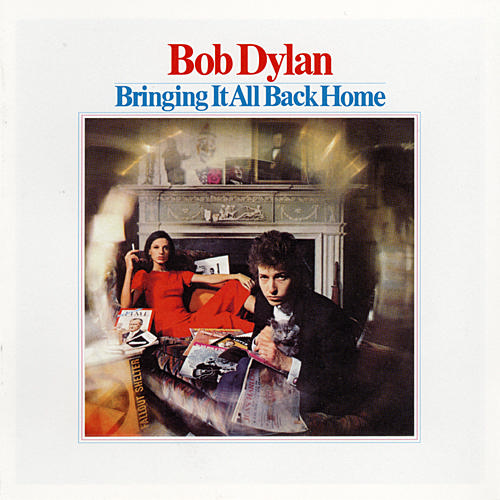Videos by American Songwriter
Whether you’re a Bob Dylan fan or not, almost everybody who hears “Mr. Tambourine Man” has to admit that it’s a pretty great song. It’s the Bob Dylan song even your grandma could love; featuring a flowing, pretty and engaging melody, vocals unobscured by grit or indebted to Bukka White, and words that soothe and beckon instead of divide. It’s the lyrical equivalent of a profoundly beautiful sunset after a productive day, and it speaks of wonders yet to come. “Take me on a trip upon your magic swirlin’ ship….I’m ready to go anywhere, I’m ready for to fade, into my own parade, cast your dancing spell my way, I promise to go under it.” Dylan may have been alluding to the effect of drugs, or he may have been singing about the effects of a good book, or a cup of tea. Or a cup of tea and a good book, on drugs. These days, it’s just a great song.
Though you might hear laughin’, spinnin’, swingin’ madly across the sun,
It’s not aimed at anyone, it’s just escapin’ on the run
and but for the sky there are no fences facin’.
And if you hear vague traces of skippin’ reels of rhyme
to your tambourine in time, it’s just a ragged clown behind,
I wouldn’t pay it any mind, it’s just a shadow you’re
seein’ that he’s chasing.
The song is nearly as famous for the Byrds’ version, which helped launch the often misunderstood, but musically rewarding “Folk Rock” genre (“I don’t play folk rock,” Dylan would repeatedly state). With their chart-topping cover, the Byrds helped prove that Bob Dylan songs could be a cottage industry unto themselves, a strategy Dylan pursued from the beginning. The Byrds transmuted it, from Dylan’s voice to Roger Mcguinn’s, who turned it into the sound of the Sixties. In the process, the Byrds cut the song in half by dropping two of the verses. Amazingly, their version was based on a demo they’d heard five days after Dylan first recorded it. You’d think they had the Internet back then or something. Dylan was a fan of the Byrd’s electric arrangement; “You can even dance to that!” he reasoned.
Dylan cut the studio version, which announces Side II of Bringing It All Back Home, on January 15th, 1965. If things had played out a little differently, it might have ended up on Another Side of Bob Dylan, the album that precedes it. On the same night that Dylan ran through every song on the album in a single take, he recorded an early version of “Mr. Tambourine Man” However, drinking buddy Ramblin’ Jack Elliott, who was in the studio at the time, added an impromptu harmony at Dylan’s suggestion, the raggedness of which helped keep the song in storage a little bit longer. This recording recently surfaced on No Direction Home: The Bootleg Series Vol. 7.
Jack Elliott: “They made a tape of Dylan and me, ‘Hey, Tambourine Man.’ I listened to it once, and I never want to hear it again. It was real bad singing. Amazingly bad.”
If the Internet has its facts straight, the iconic Bringing It All Back Home take was recorded with Dylan’s guitar in dropped D tuning, capoed at the third fret. Folk guitarist and Greenwich Village stalwart Bruce Langhorne provides the stirring electric guitar accompaniment. Langhorne’s guitar work is all over the album, most prominently on “She Belongs to Me” and “Love Minus Zero/No Limit.” In the liner notes to Biograph, Dylan says “Mr. Tambourine Man,” I think, was inspired by Bruce Langhorne. Bruce was playing guitar with me on a bunch of the early records. On one session, (producer) Tom Wilson had asked him to play tambourine. And he had this gigantic tambourine. It was like, really big. It was as big as a wagon-wheel. He was playing, and this vision of him playing this tambourine just stuck in my mind. He was one of those characters…he was like that. I don’t know if I’ve ever told him that.” Howard Sounes, in his book “Down The Highway,” points out that the phrase “jingle jangle morning” appears in a recording by hipster poet Lord Buckley. He also claims that Dylan has cited Fellini’s La Strada as an influence on the song’s imagery.
“Mr. Tambourine Man” is a seminal song from the heady days of the mid-60s, but its power has been long lasting and boundary-defying. Artists who’ve covered it range from Judy Collins to indie rockers Cloud Cult. Perhaps no one has done it better than the great William Shatner, who gives the song a bizarre spoken-word treatment on his 1968 album The Transformed Man. When Jason Castro performed the song on American Idol in 2008, he forgot a line to the lyrics. Don’t worry, Castro, it happens to everybody, including the man himself (although he just makes up new ones.)
Hunter S. Thompson, who took his own life in 2005, made sure the song was played at his funeral as his ashes were shot out of a giant cannon. Thompson dedicated his most famous work, Fear and Loathing In Las Vegas, in part to the famous songwriter. “To Bob Geiger, for reasons that need not be explained here — and to Bob Dylan, for Mister Tambourine Man.”







Leave a Reply
Only members can comment. Become a member. Already a member? Log in.